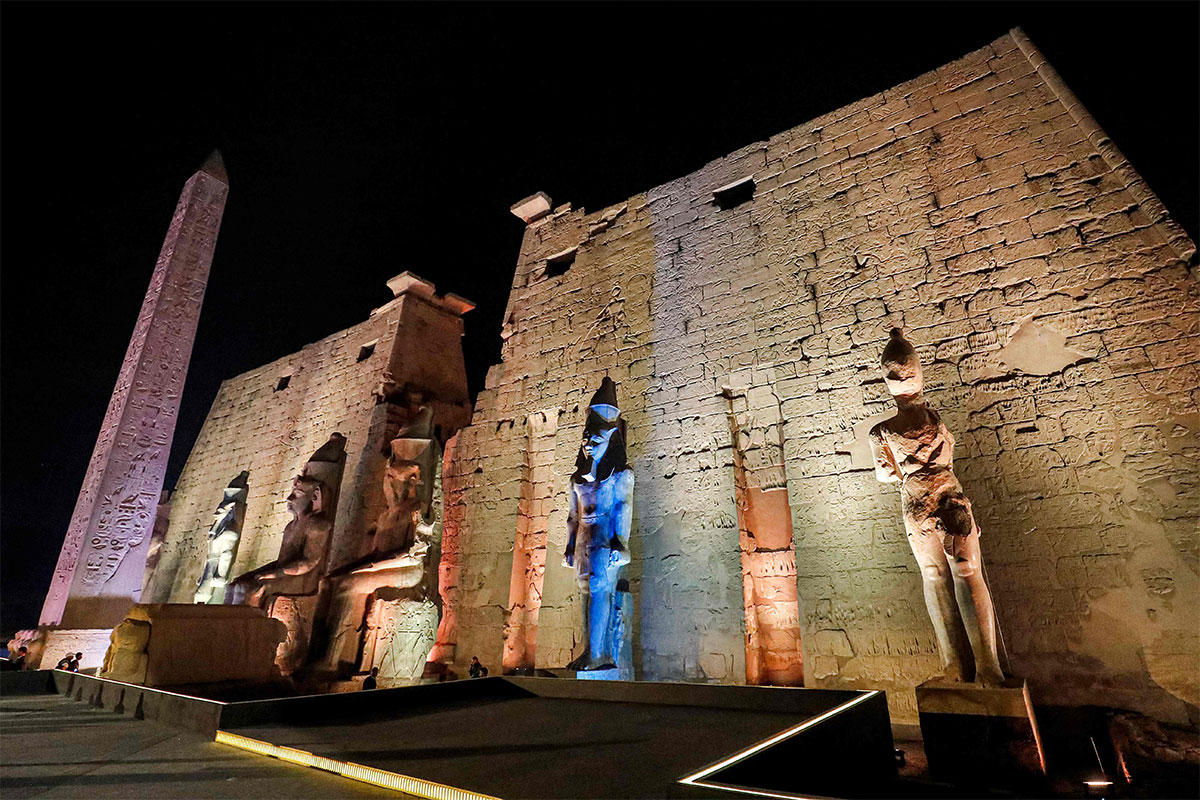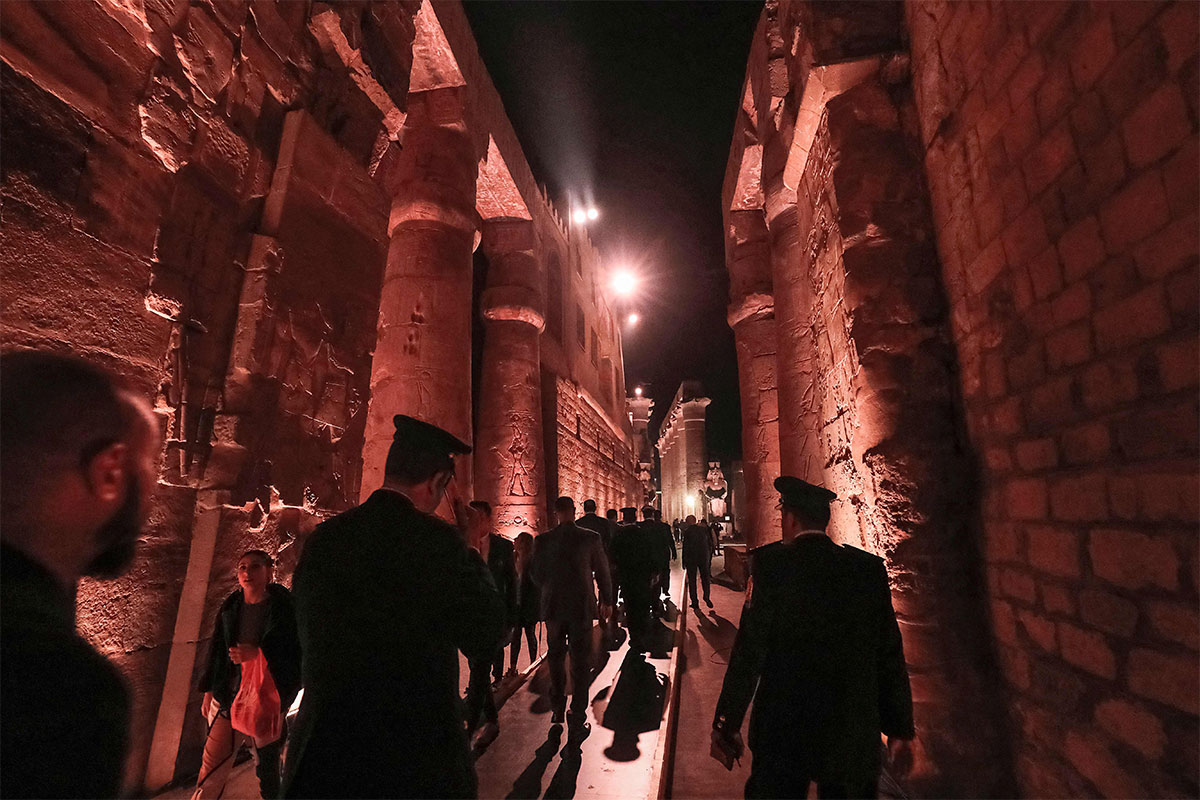
This picture taken on November 25, 2021 shows a view of the human-headed sphinxes along the 2700-metre-long Rams Road leading from the Temple of Luxor (background) to the Karnak Temple (unseen) further north, in Egypt s southern city of the same name. - Egypt on November 25 unveiled in a grandiose night-time ceremony the Rams Road (Tareeq al-Kebbash in Arabic), a 2700-metre-long sandstone-paved path lined with ram-headed statues and sphinxes dating over 3000-years-old connecting the Luxor Temple with the Karnak Temple. Named The Path of God in Ancient Egyptian mythology, its ram statues -- an embodiment of the ancient Egyptian deity Amun -- were buried for centuries under the sand before being revived and restored for display in recent years. AFP

An Egyptian policeman takes a photo of another posing by the lit-up pylon at the entrance of the Temple of Luxor (built around 1400 BC) in Egypt s southern city of the same name on November 25, 2021, after the official ceremony opening the Rams Road . - Egypt on November 25 unveiled in a grandiose night-time ceremony the Rams Road (Tareeq al-Kebbash in Arabic), a 2700-metre-long sandstone-paved path lined with ram-headed statues and sphinxes dating over 3000-years-old connecting the Luxor Temple with the Karnak Temple. Named The Path of God in Ancient Egyptian mythology, its ram statues -- an embodiment of the ancient Egyptian deity Amun -- were buried for centuries under the sand before being revived and restored for display in recent years. AFP

TOPSHOT - Fireworks light the sky during the official ceremony opening the Rams Road outside the pylon and remaining obelisk at the entrance of the Temple of Luxor (built around 1400 BC) in Egypt s southern city of the same name on November 25, 2021. The Luxor temple obelisk s twin is currently at Paris Place de la Concorde. - Egypt on November 25 unveiled in a grandiose night-time ceremony the Rams Road (Tareeq al-Kebbash in Arabic), a 2700-metre-long sandstone-paved path lined with ram-headed statues and sphinxes dating over 3000-years-old connecting the Luxor Temple with the Karnak Temple. Named The Path of God in Ancient Egyptian mythology, its ram statues -- an embodiment of the ancient Egyptian deity Amun -- were buried for centuries under the sand before being revived and restored for display in recent years. AFP

A photographer stands in the middle of the Avenue of Sphinxes commonly known as El Kebbash Road following the official ceremony of the opening of the ancient walkway on Thursday, Nov. 25, 2021, in Luxor, Egypt. The ceremony was meant to highlight the country s archaeological treasures as Egypt struggles to revive its tourism industry, battered by years of political turmoil and more lately, the coronavirus pandemic. AP

Performers take part in the reopening ceremony of the Avenue of Sphinxes commonly known as El Kebbash Road on Thursday, Nov. 25, 2021 in Luxor, Egypt. The ceremony was meant to highlight the country s archaeological treasures as Egypt struggles to revive its tourism industry, battered by years of political turmoil and more lately, the coronavirus pandemic. AP

Fireworks light the sky during the reopening ceremony of the Avenue of Sphinxes commonly known as El Kebbash Road on Thursday, Nov. 25, 2021 in Luxor, Egypt. The ceremony was meant to highlight the country s archaeological treasures as Egypt struggles to revive its tourism industry, battered by years of political turmoil and more lately, the coronavirus pandemic. AP

Fireworks light the sky during the reopening ceremony of the Avenue of Sphinxes commonly known as El Kebbash Road on Thursday, Nov. 25, 2021 in Luxor, Egypt. The ceremony was meant to highlight the country s archaeological treasures as Egypt struggles to revive its tourism industry, battered by years of political turmoil and more lately, the coronavirus pandemic. AP

This picture taken on November 25, 2021 shows a view of the human-headed sphinxes along the 2700-metre-long Rams Road leading from the Temple of Luxor (background) to the Karnak Temple (unseen) further north, in Egypt s southern city of the same name. - Egypt on November 25 unveiled in a grandiose night-time ceremony the Rams Road (Tareeq al-Kebbash in Arabic), a 2700-metre-long sandstone-paved path lined with ram-headed statues and sphinxes dating over 3000-years-old connecting the Luxor Temple with the Karnak Temple. Named The Path of God in Ancient Egyptian mythology, its ram statues -- an embodiment of the ancient Egyptian deity Amun -- were buried for centuries under the sand before being revived and restored for display in recent years. AFP

This picture taken on November 25, 2021 shows a general view of the lit-up pylon and remaining obelisk at the entrance of the Temple of Luxor (built around 1400 BC) in Egypt s southern city of the same name. The Luxor temple obelisk s twin is currently at Paris Place de la Concorde. - Egypt on November 25 unveiled in a grandiose night-time ceremony the Rams Road (Tareeq al-Kebbash in Arabic), a 2700-metre-long sandstone-paved path lined with ram-headed statues and sphinxes dating over 3000-years-old connecting the Luxor Temple with the Karnak Temple. Named The Path of God in Ancient Egyptian mythology, its ram statues -- an embodiment of the ancient Egyptian deity Amun -- were buried for centuries under the sand before being revived and restored for display in recent years. AFP

Egyptian policemen are seen as visitors walk about at night at the Temple of Luxor (built around 1400 BC) in Egypt s southern city of the same name on November 25, 2021, after the official ceremony opening the Rams Road . - Egypt on November 25 unveiled in a grandiose night-time ceremony the Rams Road (Tareeq al-Kebbash in Arabic), a 2700-metre-long sandstone-paved path lined with ram-headed statues and sphinxes dating over 3000-years-old connecting the Luxor Temple with the Karnak Temple. Named The Path of God in Ancient Egyptian mythology, its ram statues -- an embodiment of the ancient Egyptian deity Amun -- were buried for centuries under the sand before being revived and restored for display in recent years. AFP

Performers carry a palanquin during the official ceremony opening the Rams Road near the Temple of Luxor (built around 1400 BC) in Egypt s southern city of the same name on November 25, 2021. - Egypt on November 25 unveiled in a grandiose night-time ceremony the Rams Road (Tareeq al-Kebbash in Arabic), a 2700-metre-long sandstone-paved path lined with ram-headed statues and sphinxes dating over 3000-years-old connecting the Luxor Temple with the Karnak Temple. Named The Path of God in Ancient Egyptian mythology, its ram statues -- an embodiment of the ancient Egyptian deity Amun -- were buried for centuries under the sand before being revived and restored for display in recent years. AFP